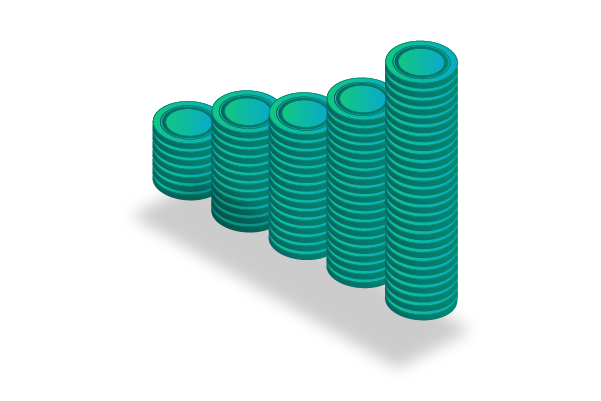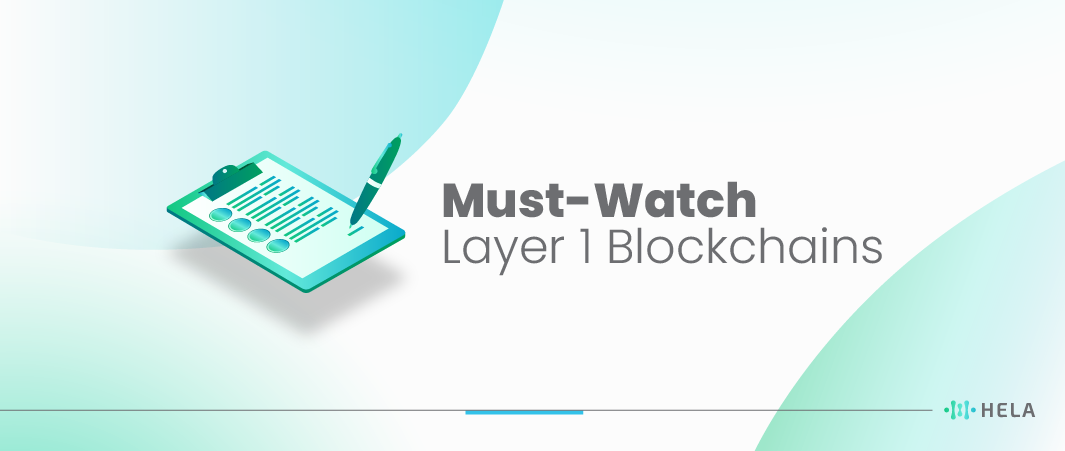The blockchain universe is vast and ever-evolving. At its core, the foundational technology that powers this decentralized world is the Layer 1 blockchain. These are the primary protocols upon which all other decentralized applications and platforms are built. As the digital age progresses, understanding these Layer 1 blockchains becomes crucial for anyone keen on the future of technology.
While many are familiar with the likes of Bitcoin and Ethereum, the landscape is teeming with innovative blockchains, each offering unique features and capabilities. This article aims to shed light on some of the most prominent Layer 1 blockchains that are shaping the decentralized future.
What is a Layer 1 Blockchain?

At the core of the decentralized ecosystem, a Layer 1 blockchain serves as the fundamental protocol on which the entire network operates. This foundational layer bears the crucial responsibilities of establishing consensus, upholding security, and preserving the overall integrity of the system. Transactions are validated and recorded on the ledgers of these primary networks, affirming their role as the bedrock of the entire blockchain landscape.
Also Read: What is Layer 1 (L1) in Blockchain?
In contrast to Layer 2 solutions, which are designed to boost scalability and speed by building upon Layer 1, these blockchains hold a unique significance as they lay the groundwork for all operations within the decentralized realm. A list of Layer 1 blockchains showcases the diversity and innovation in this realm, highlighting their pivotal role in shaping the broader blockchain ecosystem.
List of Top Layer 1 Blockchains

Layer 1 blockchains are the foundational protocols of the decentralized digital landscape. They serve as the underlying architecture upon which various decentralized applications (DApps), smart contracts, and other blockchain-based functionalities are built. These blockchains often have unique features, consensus mechanisms, and programming languages that set them apart from one another. Here is a list of some of the top Layer 1 blockchains:
1. HeLa
At the forefront of Web 3.0’s transformative vision stands HeLa, poised to revolutionize how individuals wield control over their digital assets and data, ushering in a new era of empowerment. This paradigm shift is anchored in a robust decentralized identity management system, fostering unshakable trust and security in every transaction.
By placing users at the heart of its ethos, this approach not only enhances overall experiences but also cultivates a profound sense of ownership within the blockchain ecosystem. HeLa, distinguished as a top player among the list of Layer 1 blockchains protocols, leads with innovative privacy measures, delicately harmonizing confidentiality and transparency to align seamlessly with regulatory requirements. Serving as a foundational framework for Layer 1 blockchain protocol, HeLa’s potential spans diverse domains like finance and supply chain management, poised to ingeniously reshape interactions within the decentralized digital realm of Web 3.0.
Key Features:
- Modular Design
- Stablecoin as Gas Fee
- Decentralized Identity (DID)
- EVM Compatibility
2. Bitcoin (BTC)
Bitcoin, the trailblazer of the blockchain movement, revolutionized the concept of decentralized digital currency and unveiled the potential of an immutable, trustless ledger. Despite its current recognition as a store of value, its role remains unrivaled in the realm of cryptocurrencies. Furthermore, in the ever-expanding list of layer 1 blockchains, Bitcoin’s impact continues to stand as a foundational pillar, setting the stage for future innovations.
Key Features:
- First and most well-known cryptocurrency.
- Created by an unknown person or group using the pseudonym Satoshi Nakamoto.
- Built on a decentralized and permissionless blockchain.
- Proof-of-Work (PoW) consensus mechanism secures the network.
- Limited supply of 21 million coins.
- Used primarily as a store of value and digital gold.
3. Ethereum (ETH)
Emerging as a globally acclaimed decentralized computer, Ethereum revolutionized the concept of smart contracts, propelling them to the forefront of technological discourse. By enabling developers to fashion decentralized applications (DApps) through its platform, Ethereum catalyzed an unprecedented surge in creative advancement. This transformative phenomenon also positions Ethereum among the prominent entities in the list of layer 1 blockchains, further underscoring its significance in the realm of decentralized technologies.
Key Features:
- A blockchain platform designed for decentralized applications (dApps) and smart contracts.
- Introduced the concept of programmable blockchain.
- Ether (ETH) is the native cryptocurrency used for transactions and executing smart contracts.
- Uses the Ethereum Virtual Machine (EVM) to execute code.
- Transitioning from Proof-of-Work (PoW) to Proof-of-Stake (PoS) consensus with Ethereum 2.0 upgrade.
- Enables creation of tokens and NFTs (Non-Fungible Tokens).
4. Binance Smart Chain (BSC)
Positioned as a strong competitor to Ethereum, Binance Smart Chain (BSC) is swiftly gaining ground due to its accelerated transaction speeds, cost-effectiveness, and seamless integration with Ethereum’s tools. Its appeal extends further with a flourishing collection of Decentralized Applications (DApps). Amidst the list of layer 1 blockchains, BSC shines as a promising choice, boasting a vibrant ecosystem and strong compatibility features.
Key Features:
- A parallel blockchain to Binance Chain, designed for smart contracts and dApps.
- Created by the cryptocurrency exchange Binance.
- Utilizes a delegated Proof-of-Stake (DPoS) consensus mechanism for faster transaction processing.
- Offers low transaction fees compared to Ethereum.
- Interoperability with Binance Chain for cross-chain transfers.
5. Polkadot (DOT)
Polkadot, conceived as a versatile multi-chain framework, strives to facilitate seamless message and value exchange across various blockchains without relying on trust. This distinctive interoperability capability sets it apart within the competitive blockchain landscape. Its innovative design not only enables different blockchains to connect and communicate but also establishes a cohesive network that includes a list of layer 1 blockchains, fostering a new level of decentralized synergy.
Key Features:
- Focuses on interoperability between multiple blockchains.
- Utilizes a multichain network with shared security.
- Employs a unique consensus algorithm called Nominated Proof-of-Stake (NPoS).
- Allows the creation of custom blockchains (parachains) that can be integrated into the network.
6. Cardano (ADA)
Utilizing a thoroughly researched methodology, Cardano has unveiled an innovative proof-of-stake consensus mechanism, distinguishing itself within the list of layer 1 blockchains. This advancement holds the potential to deliver heightened sustainability and scalability to smart contracts and DApps, addressing key challenges in the blockchain landscape. By incorporating cutting-edge research, Cardano aims to offer a robust foundation for decentralized applications, redefining the possibilities for the future of blockchain technology.
Key Features:
- A blockchain platform with a research-driven approach to development.
- Founded by Ethereum co-founder Charles Hoskinson.
- Utilizes the Ouroboros Proof-of-Stake (PoS) consensus algorithm.
- Emphasizes scalability, sustainability, and security.
- Divided into layers for separating computation and settlement.
7. Solana (SOL)
Renowned for its exceptional transaction speeds and economical transaction costs, Solana is rapidly gaining popularity among developers who seek enhanced scalability without undermining the crucial aspect of security. As one of the prominent names on the list of layer 1 blockchains, Solana stands out for its ability to provide swift transactions and affordability, making it an attractive choice for developers in need of a robust ecosystem.
Key Features:
- A high-performance blockchain designed for decentralized applications and crypto-currencies.
- Employs a unique consensus mechanism called Proof-of-History (PoH) combined with Proof-of-Stake (PoS).
- Offers fast transaction speeds and low fees.
- Supports smart contracts and decentralized finance (DeFi) applications.
- Known for its focus on scalability and throughput.
The Significance of Layer 1 Blockchains in the Digital Economy

In the rapidly expanding digital economy, the significance of Layer 1 blockchains cannot be emphasized enough. Serving as the fundamental infrastructure for a wide array of applications and platforms that are revolutionizing various industries, these foundational protocols play a pivotal role. As an illustrative example, a comprehensive list of Layer 1 blockchains underscores their essential contribution to shaping the technological landscape and driving innovation across sectors.
1. Decentralized Finance (DeFi)
The DeFi movement has been catalyzed by Layer 1 blockchains, which have paved the way for the revolutionizing of the financial sector by enabling the operation of financial systems devoid of intermediaries. This transformative shift is evident in the proliferation of decentralized exchanges, lending and borrowing platforms, and various other innovative mechanisms, ultimately redefining how financial activities are conducted. A notable list of Layer 1 blockchains contributing to this paradigm shift includes Hela, Ethereum, Binance Smart Chain, Solana, and Avalanche, each fostering a dynamic ecosystem of decentralized financial applications.
2. Supply Chain Management
Utilizing transparent and immutable ledgers, Layer 1 blockchains are revolutionizing supply chains by enhancing authenticity, enabling comprehensive traceability, and significantly mitigating fraudulent activities. These advancements are fostering remarkable gains in the efficiency and reliability of global trade. A comprehensive list of Layer 1 blockchains implementation further underscores the transformative potential of this technology across various industries.
3. Digital Identity
Amidst a landscape plagued by frequent data breaches, the emergence of Layer 1 blockchains brings forth a promising remedy for safeguarding digital identities. These innovative platforms empower individuals by granting them direct authority over their personal information, reinforcing privacy measures in the process. In this realm, a diverse list of Layer 1 blockchains stands ready to champion the cause of secure online identities and data protection.
Also Read: 15 Best Liquid Staking Platforms to Consider in 2024
4. Gaming and Virtual Realities
The gaming industry is currently undergoing a transformative revolution through the incorporation of blockchain technology. This innovation is made possible by Layer 1 protocols, which facilitate the tokenization of in-game assets, the establishment of decentralized gaming ecosystems, and the emergence of novel economies within virtual realms. A growing list of Layer 1 blockchains is driving this trend, empowering the creation of dynamic and interconnected virtual worlds..
Understanding the profound impact of Layer 1 blockchains on the digital economy is essential. They are not just technological innovations; they are catalysts for a more transparent, efficient, and inclusive global ecosystem.
Conclusion
The world of Layer 1 blockchains is dynamic and filled with potential. As the backbone of the decentralized web, these blockchains play a pivotal role in determining the direction of digital innovation. Whether you’re an investor, developer, or just a tech enthusiast, keeping an eye on these Layer 1 blockchains is essential. They not only represent the future of technology but also the promise of a more decentralized and equitable digital world.
In the years to come, as technology continues to evolve, we can expect even more groundbreaking innovations from the Layer 1 blockchain space. The race is on, and the decentralized future looks brighter than ever. Dive in, explore, and be part of the revolution!
Disclaimer:
The information provided by Hela Labs in this article is intended for general informational purposes and does not reflect the company’s opinion. It is not intended as investment advice or recommendations. Readers are strongly advised to conduct their own thorough research and consult with a qualified financial advisor before making any financial decisions.

Joshua Soriano
I am Joshua Soriano, a passionate writer and devoted layer 1 and crypto enthusiast. Armed with a profound grasp of cryptocurrencies, blockchain technology, and layer 1 solutions, I've carved a niche for myself in the crypto community.
- Joshua Soriano#molongui-disabled-link
- Joshua Soriano#molongui-disabled-link
- Joshua Soriano#molongui-disabled-link
- Joshua Soriano#molongui-disabled-link

